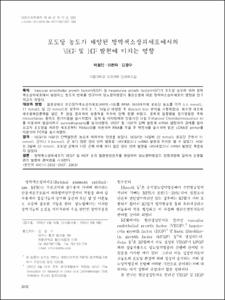포도당 농도가 배양된 망막색소상피세포 에서의 VEGF 및 HGF 발현에 미치는 영향
- Keimyung Author(s)
- Kim, Kwang Soo
- Department
- Dept. of Ophthalmology (안과학)
- Journal Title
- 대한안과학회지
- Issued Date
- 2003
- Volume
- 44
- Issue
- 11
- Abstract
- Purpose: To evaluate the expression of vascular endothelial growth factor (VEGF) and hepatocyte growth factor (HGF) in response to high glucose concentration in human retinal pigement epithelial (RPE) cells. Methods: After confluent adult human RPE cells (ARPE-19) were cultured in RPMI 1640 media containing three different concentration of glucose (5.5,11 and 22 mmol/L) for 3,7 and 14 days, Western blot analysis was performed. Cell pellets were lysed in lysis buffer and cell lysates were centrifused to collect supernatant fractions for quantifying protein concentration. The proteins were subjected to electrophoresis and transferred to nitrocellulose membranes. After the blots were incubated with primary and secondary antibody to VEGF or HGF consecutively, enhanced chemiluminescence and autoradiography were performed. To evaluate the relationship between protein and mRNA expression, RNA from glucose-treated RPE cells was obtained by using RNAzolB. After cDNA was obtained through reverse transcription of RNA, PCR of cDNA was performed by using primers.
Results: We found that incubation with different concentrations of glucose increased the protein expression of VEGF and HGF in concentration-dependent manner in RPE. At 14 days, level of VEGF protein expression was higher in 22 mmol/L glucose group than in other two groups (5.5 mmol/L or 11 mmol/L), but no differences of mRNA expression of VEGF were observed in each group. At 3 days, level of HGF protein expression was higher in 22 mmol/L glucose group than in other groups, but mRNA expression of HGF was not detected in all groups.
Conclusions: These results suggest that RPE cells may participate in angiogenesis in progression of diabetic retinopathy through production of VEGF and HGF.
목적 : Vascular endothelial growth factor(VEGF) 및 hepatocyte growth factor(HGF)가 포도당 농도에 따라 망막 색소 상피세포에서 발현되는 정도의 변화를 연구하여 당뇨망막병증의 혈관신생에 대한 망막색소 상피세포의 영향을 연구 하고자 하였다.
대상과 방법 : 밀생상태의 인간망막색소상피세포(ARPE-19)를 RPMI 1640배지에 포도당 농도를 각각 5.5 mmol/L, 11 mmol/L 및 22 mm이/L로 맞추어 각각 3, 7, 14일간 배양한 후 Western blot 분석을 시행하였다. 회수한 세포에 세포용해완충액을 넣은 후 원심 분리하여 상층액을 취하여 단백 정량 하였고, 분획의 일정량을 전기영동한 후에 nitrocellulose 종이로 전기이동을 실시하였다. 일차 및 이차항체와 반응시킨 다음 Enhanced Chemiluminescence kit 를 이용하여 발광시키고 autoradiography를 실시하였다. VEGF 및 HGF의 단백 발현과 mRNA 발현과의 관계를 알아 보고자 포도당을 처리한 세포로부터 RNAzolB를 이용하여 RNA를 추출 후 역전사를 실시하여 얻은 cDNA로 primer를 이용하여 PCR을 실시하였다.
결과 : VEGF와 HGF의 단백발현은 농도에 비례하는 양상을 보였다. VEGF는 14일째 22 mmol/L 포도당 군에서 11 mmol/L 군이나 5.5mm이/L 군 보다 많은 양의 단백 발현을 나타내었으나 mRNA 발현의 차이는 볼 수 없었다. HGF 는 3일째 22 mmol/L 포도당 군에서 다른 군에 비해 보다 많은 양의 단백 발현을 나타내었으나 mRNA 발현은 측정되지 않았다.
결론 : 망막색소상피세포가 VEGF 및 HGF 등의 혈관생성인자를 생성하여 당뇨망막병증의 진행과정에 있어서 신생혈 관의 발생에 관여함을 시사한다.
- Alternative Title
- The Effect of Glucose Concentration on Expression of VEGF and HGF in Cultured Human RPE Cells
- Keimyung Author(s)(Kor)
- 김광수
- Publisher
- School of Medicine
- Citation
- 백철민 et al. (2003). 포도당 농도가 배양된 망막색소상피세포 에서의 VEGF 및 HGF 발현에 미치는 영향. 대한안과학회지, 44(11), 2652–2657.
- Type
- Article
- ISSN
- 0378-6471
- Appears in Collections:
- 1. School of Medicine (의과대학) > Dept. of Ophthalmology (안과학)
- 파일 목록
-
-
Download
 oak-bbb-02700.pdf
기타 데이터 / 240.64 kB / Adobe PDF
oak-bbb-02700.pdf
기타 데이터 / 240.64 kB / Adobe PDF
-
Items in Repository are protected by copyright, with all rights reserved, unless otherwise indicated.